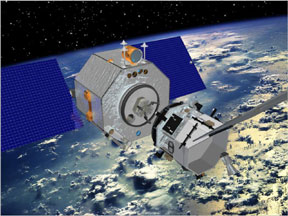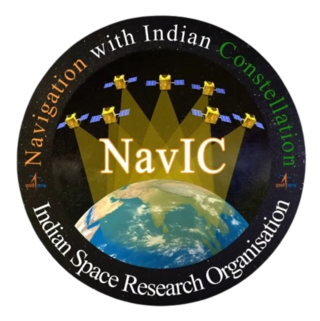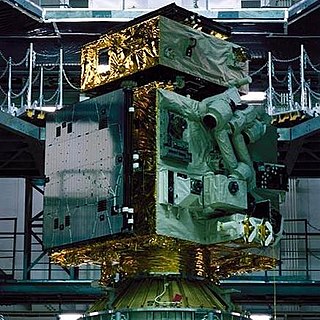Related Research Articles

The Polar Satellite Launch Vehicle (PSLV) is an expendable medium-lift launch vehicle designed and operated by the Indian Space Research Organisation (ISRO). It was developed to allow India to launch its Indian Remote Sensing (IRS) satellites into Sun-synchronous orbits, a service that was, until the advent of the PSLV in 1993, only commercially available from Russia. PSLV can also launch small size satellites into Geostationary Transfer Orbit (GTO).

The Indian Space Research Organisation is the national space agency of India. It operates as the primary research and development arm of the Department of Space (DoS), which is directly overseen by the Prime Minister of India while the Chairman of ISRO also acts as the executive of DoS. ISRO is primarily responsible for performing tasks related to space-based operations, space exploration, international space cooperation and the development of related technologies. ISRO is one of the six government space agencies in the world that possesses full launch capabilities, can deploy cryogenic engines, can launch extraterrestrial missions and operate a large fleet of artificial satellites. ISRO is one of the four government space agencies to have soft landing (uncrewed) capabilities.

Aryabhata was India's first satellite, named after the astronomer. It was launched on 19 April 1975 from Kapustin Yar, a Soviet rocket launch and development site in Astrakhan Oblast using a Kosmos-3M launch vehicle. It was built by ISRO, and launched by the Soviet Union as a part of the Soviet Interkosmos programme which provided access to space for friendly states.

Satish Dhawan Space Centre – SDSC, is the primary spaceport of the Indian Space Research Organisation (ISRO), located in Sriharikota, Andhra Pradesh.

Orbital Express was a space mission managed by the United States Defense Advanced Research Projects Agency (DARPA) and a team led by engineers at NASA's Marshall Space Flight Center (MSFC). The Orbital Express program was aimed at developing "a safe and cost-effective approach to autonomously service satellites in orbit". The system consisted of two spacecraft: the ASTRO servicing satellite, and a prototype modular next-generation serviceable satellite; NEXTSat. The mission launched from Cape Canaveral Air Force Station on 8 March 2007, aboard an Atlas V expendable launch vehicle. The launch was part of the United States Air Force Space Test Program STP-1 mission.

The Launch Vehicle Mark-3 or LVM3 is a three-stage medium-lift launch vehicle developed by the Indian Space Research Organisation (ISRO). Primarily designed to launch communication satellites into geostationary orbit, it is also due to launch crewed missions under the Indian Human Spaceflight Programme. LVM3 has a higher payload capacity than its predecessor, GSLV.

The Indian Human Spaceflight Programme (IHSP) is an ongoing programme by the Indian Space Research Organisation (ISRO) to develop the technology needed to launch crewed orbital spacecraft into low Earth orbit. Three uncrewed flights, named Gaganyaan-1, Gaganyaan-2 and Gaganyaan-3 are scheduled to launch in 2024, followed by crewed flight in 2024 on an LVM3 rocket.

The Indian Regional Navigation Satellite System (IRNSS), with an operational name of NavIC, is an autonomous regional satellite navigation system that provides accurate real-time positioning and timing services. It covers India and a region extending 1,500 km (930 mi) around it, with plans for further extension. An extended service area lies between the primary service area and a rectangle area enclosed by the 30th parallel south to the 50th parallel north and the 30th meridian east to the 130th meridian east, 1,500–6,000 km (930–3,730 mi) beyond borders where some of the NavIC satellites are visible but the position is not always computable with assured accuracy. The system currently consists of a constellation of eight satellites, with two additional satellites on ground as stand-by.

The ETS-VII, or Engineering Test Satellite No. 7, was a satellite developed and launched by the National Space Development Agency of Japan (NASDA). It is also known as KIKU-7. It was launched aboard an H-II rocket from Tanegashima Space Center, on 28 November 1997. The ETS-VII was equipped with a 2-meter-long (6.6 ft) robotic arm, which was used to carry out several experiments related to rendezvous docking and space robotics. It was the world's first satellite to be equipped with a robotic arm, and also Japan's first uncrewed spacecraft to conduct autonomous rendezvous and docking operations successfully, decades after the docking of the Soviet Kosmos 186 and Kosmos 188 spacecraft in 1967. Although it was originally intended to be used for 1.5 years, the satellite was functional for a period of almost five years. ETS-VII eventually decayed from orbit on 13 November 2015.

Chandrayaan-2 is the second lunar exploration mission developed by the Indian Space Research Organisation (ISRO) after Chandrayaan-1. It consists of a lunar orbiter, the Vikram lunar lander, and the Pragyan rover, all of which were developed in India. The main scientific objective is to map and study the variations in lunar surface composition, as well as the location and abundance of lunar water.

Gaganyaan is an Indian crewed orbital spacecraft intended to be the formative spacecraft of the Indian Human Spaceflight Programme. The spacecraft is being designed to carry three people, and a planned upgraded version will be equipped with rendezvous and docking capabilities. In its maiden crewed mission, the Indian Space Research Organisation (ISRO)'s largely autonomous 5.3-metric ton capsule will orbit the Earth at 400 km altitude for up to seven days with a two- or three-person crew on board. The first crewed mission was originally planned to be launched on ISRO's LVM3 rocket in December 2021. As of October 2023, it is expected to be launched by 2025.

Docking and berthing of spacecraft is the joining of two space vehicles. This connection can be temporary, or partially permanent such as for space station modules.

The Mars Orbiter Mission (MOM), unofficially known as Mangalyaan, was a space probe orbiting Mars since 24 September 2014. It was launched on 5 November 2013 by the Indian Space Research Organisation (ISRO). It was India's first interplanetary mission and it made ISRO the fourth space agency to achieve Mars orbit, after Roscosmos, NASA, and the European Space Agency. It made India the first Asian nation to reach the Martian orbit and the first nation in the world to do so on its maiden attempt.
GSAT-7 or INSAT-4F is a multi-band military communications satellite developed by the Indian Space Research Organisation. The Indian Navy is the user of the multi-band communication spacecraft, which has been operational since September 2013. According to defense experts, the satellite will enable the navy to extend its blue water capabilities and stop relying on foreign satellites like Inmarsat, which provide communication services to its ships.

GSAT-6A was a communication satellite launched by the Indian Space Research Organisation (ISRO) It featured a 6-metre (20 ft) unfurlable S-band antenna similar to the one used on GSAT-6. Around 17 minutes after lift-off, the three stage GSLV Mk.II rocket flying on GSLV F08 mission successfully injected the satellite into a geosynchronous transfer orbit. Due to power failure during its orbit raising burns the communication was lost with GSAT-6A before it could reach its final circular geostationary orbit (GSO).

GSAT-29 is a high-throughput communication satellite developed by the Indian Space Research Organisation (ISRO). The mission aims at providing high-speed bandwidth to Village Resource Centres (VRC) in rural areas. The two Ku and Ka operational payloads will provide communication services to Jammu and Kashmir and Northeast India under Digital India programme. At the time of launch GSAT-29 was the heaviest satellite, weighing 3,423 kg (7,546 lb), that was placed in orbit by an Indian launch vehicle. Approved cost of GSAT-29 is ₹175.63 crore (US$22 million).

Microsat-R was claimed to be an experimental imaging satellite manufactured by DRDO and launched by Indian Space Research Organisation on 24 January 2019 for military use. The satellite served as a target for an anti-satellite test on 27 March, 2019.

The Human Space Flight Centre (HSFC) is a body under the Indian Space Research Organisation (ISRO) to coordinate the Indian Human Spaceflight Programme. The agency will be responsible for implementation of the Gaganyaan project. The first crewed flight is planned for 2024 on a home-grown LVM3 rocket.
References
- ↑ "Government Of India, Department Of Space, Lok Sabha Unstarred Question No. 556 to be answered on Wednesday, July 20, 2022 about 'Private Participation In Space'" (PDF). 20 July 2022. Archived from the original (PDF) on 20 July 2022.
- 1 2 "Department of Space Annual Report 2018-19" (PDF). Department of Space. 27 May 2019. Archived (PDF) from the original on 27 May 2019. Retrieved 2 October 2019.
- ↑ "Department of Space Outcome Budget 2013-14" (PDF). Department of Space. Archived (PDF) from the original on 5 February 2022.
- ↑ "Dual-Lever Rigidisation Mechanism With A Self-Hold Down Feature For Autonomous Docking Of Spacecraft". 9 September 2022.
- ↑ Chacko, T.; B P, Dakshayani; Vighnesam, N.; Gopinath, N.S. (1 October 2012). Relative state vector generation algorithm for on board navigation for rendezvous docking experiment. 63rd International Astronautical Congress. Vol. 7. pp. 5313–5316.
- ↑ Ramesh, M. (1 October 2019) [30 September 2019]. "ISRO's space docking experiment to happen next year, says Sivan". The Hindu BusinessLine. Archived from the original on 15 April 2022. Retrieved 2 October 2019.
- ↑ Mehta, Jatan (27 June 2019). "5 Unique Space Science Missions That ISRO Will Be Flying in the Near Future". The Wire. Archived from the original on 15 April 2022. Retrieved 2 October 2019.
- ↑ Singh, Surendra (3 October 2019). "Isro to hold space-docking experiment next year, a step towards setting up space station". The Times of India. Archived from the original on 15 April 2022. Retrieved 3 October 2019.
- ↑ "Development of end effectors for spacecraft berthing and sample retrieval". www.indiascienceandtechnology.gov.in. Department of Science and Technology. Archived from the original on 15 April 2022. Retrieved 26 December 2021.
- ↑ "RESPOND Basket 2021" (PDF). Indian Space Research Organisation. Archived (PDF) from the original on 26 December 2021.
- ↑ "Research Areas in Space 2021" (PDF). Indian Space Research Organisation. Archived (PDF) from the original on 15 April 2022.
- ↑ Kumar, Chethan (2 May 2017). "ISRO: Isro project that can aid refuel, repair of satellites in space gets push". The Times of India. Archived from the original on 4 November 2021. Retrieved 2 October 2019.
- ↑ "Detailed Demands for Grants of Department of Space for 2018-2019" (PDF). Indian Space Research Organisation. Archived from the original (PDF) on 22 November 2018.
- ↑ "Announcement of Opportunity (AO) for Orbital platform: An avenue for in-orbit scientific experiments" (PDF). Indian Space Research Organisation. 15 June 2019. Archived (PDF) from the original on 2 October 2019. Retrieved 2 October 2019.